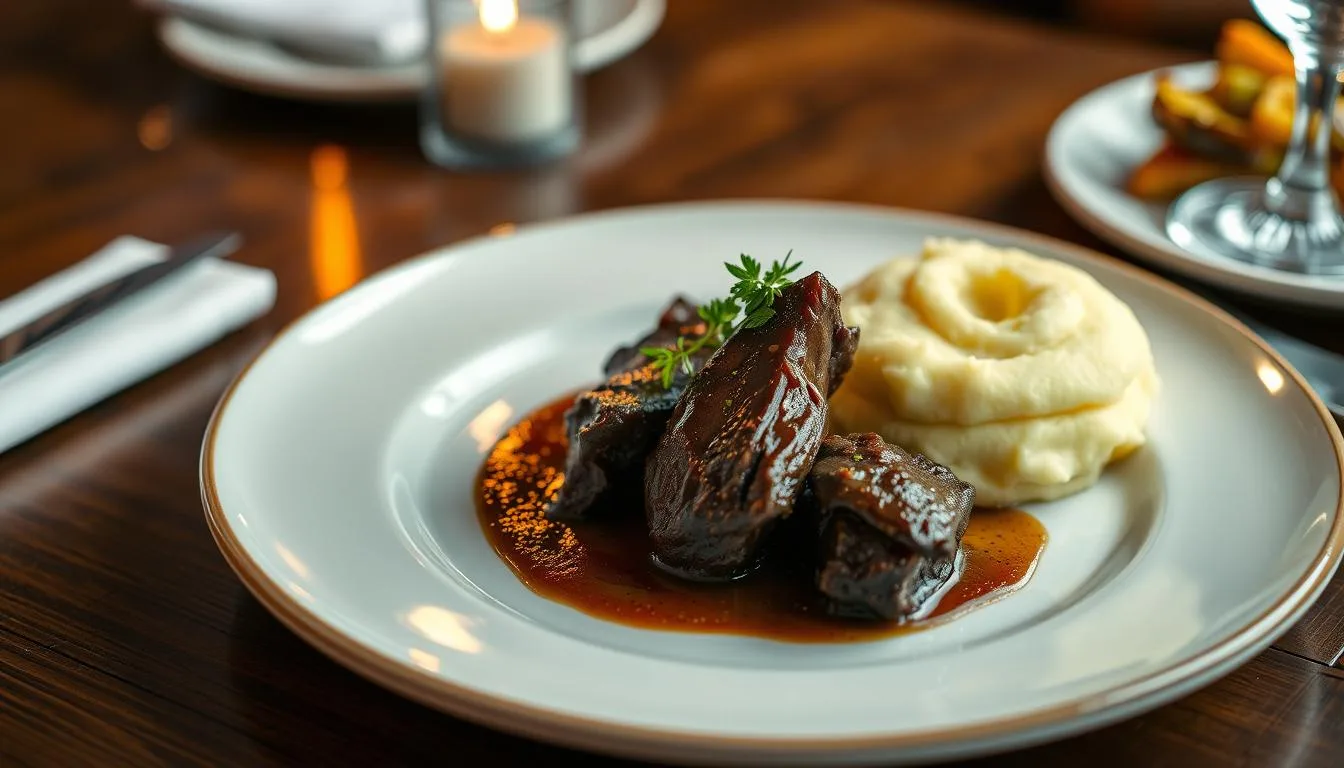Table of Contents
Ever wondered about beef cheeks? They’re hidden gems from the cow’s hard-working face muscles. Rich and tender, they’re great for a high-protein diet or a cozy meal. But how do you make them tender and flavorful every time? Let’s explore the secret to cooking beef cheeks like a pro.
Key Takeaways
- Beef cheeks are an inexpensive, protein-rich cut of meat with a unique, tender texture.
- Slow cooking methods, such as braising or slow-roasting, are the key to unlocking the delicious beef cheeks.
- Proper seasoning and flavor combinations can elevate beef cheeks to new heights of culinary delight.
- Serving beef cheeks with the right side dishes can create a truly memorable meal.
- Careful storage and reheating techniques can help you enjoy your beef cheeks to the fullest.
Understanding Beef Cheeks: A Hidden Culinary Gem
Beef cheeks are a hidden gem in cooking. They may look tough, but they become tender and flavorful when cooked right. They are often ignored, but they should be celebrated as a gourmet meat.
What Makes Beef Cheeks Special
Beef cheeks follow the nose-to-tail eating idea. They have a rich flavor, like oxtails or pot roast. Cooking them slow breaks down the tough texture, making them tender.
Nutritional Benefits and Protein Content
Beef cheeks are tasty and nutritious. They have 209 calories, 26.7g of protein, and 4.3g of collagen per 100g. This is more than beef tenderloin, which has less collagen. They are great for skin, joint, and gut health.
Why Choose This Cut of Meat
Beef cheeks are a great value. They are cheaper than fancy cuts but taste amazing. They are perfect for a meat-focused meal.
Essential Equipment for Cooking Beef Cheeks
When making delicious slow cooking recipes with beef cheeks, the right tools are important. As someone who loves braised meats, I’ve learned that certain tools are key. They help make the meat tender and full of flavor.
A good slow cooker is a must. It cooks the beef cheeks slowly, breaking down the tough parts. A heavy pot or oven-safe dish also works well for cooking on the stovetop or in the oven.
You’ll need a sharp knife to cut and prepare the beef cheeks. Cutting off any extra fat or silver skin makes the meat even. A meat thermometer is also useful. It helps you know when the meat is tender, at about 200°F.
For the sauce, you’ll need a small saucepan and a whisk. These tools help you mix and thicken the sauce easily. They make it simple to add herbs and spices too.
| Essential Equipment | Purpose |
|---|---|
| Slow Cooker | Gently tenderizes beef cheeks over several hours |
| Heavy-Based Pot or Casserole Dish | Suitable for stovetop or oven braising |
| Sharp Knife | Trims and preps the beef cheeks |
| Meat Thermometer | Ensures the beef cheeks reach the optimal internal temperature |
| Small Saucepan and Whisk | Facilitates sauce and gravy preparation |
With these tools, you’re ready to make tender and tasty beef cheeks. They will impress your guests and satisfy your taste buds. Start exploring slow cooking recipes and braised meats now!
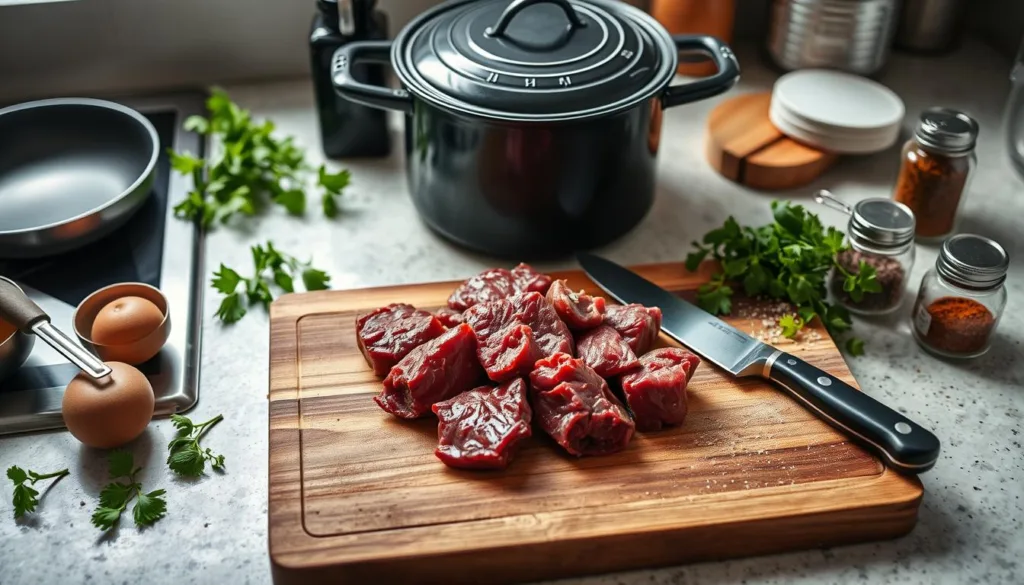
Selecting and Preparing Your Beef Cheeks
I love cooking with beef cheeks. They are tasty and affordable. But, picking and getting them ready needs some skill. Let’s look at how to make sure your beef cheeks are tender and tasty.
How to Choose Quality Cuts
When you buy beef cheeks, look for ones with little sinew and fat. They should feel firm and look rich in color. Stay away from cheeks that look dry or have bad color. Your local butcher is often the best source for high-quality, fresh beef cheeks.
Trimming and Cleaning Tips
- Remove any sinew or fat before cooking. This tough stuff won’t soften during cooking.
- Rinse the cheeks under cool water and dry them with paper towels. This gets rid of dirt.
- For the best texture, cut or slice the cheeks into even pieces before cooking.
Proper Portion Sizing
Beef cheeks can be different sizes, from 8 to 16 ounces raw. Most are about 12 ounces raw and cook down to 6 ounces. One cheek or 6 ounces of cooked beef cheeks is typically considered a generous serving.
By following these tips, you’ll get great beef cheeks for your next meal. Remember, these budget protein sources are special. So, choose them from your local butcher offerings and make them shine in your cooking.
The Science Behind Tender Beef Cheeks
Getting beef cheeks to melt in your mouth is all about the science. It’s about slow cooking that breaks down tough fibers. This turns them into a soft, gelatinous texture.
Beef cheeks have slow-twitch muscle fibers for endurance, not speed. They are wrapped in collagen-rich tissues for support and movement. When cooked slowly, the collagen turns into gelatin. This makes the beef cheeks tender and juicy.
Cooking in a moist environment, like braising, keeps the meat moist. As collagen breaks down, it releases moisture. This makes the dish juicy and flavorful. It also makes the beef cheeks a nutritious choice for your meals.
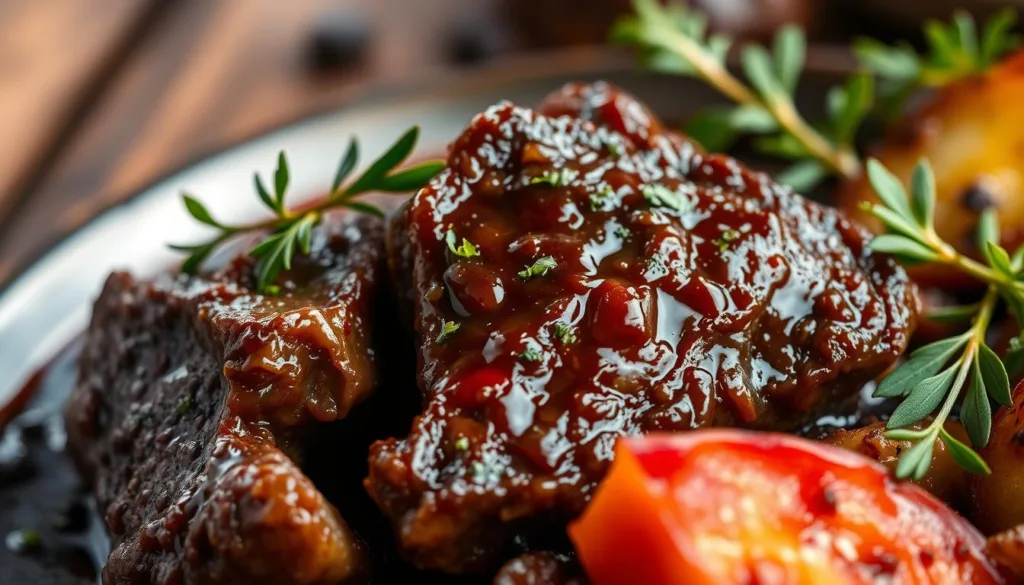
Knowing how beef cheeks become tender is key to cooking them well. Slow cooking breaks down the connective tissues. This turns a usually overlooked cut into a special dish.
Perfect Seasoning Combinations and Spice Blends
Improving the taste of tender beef cheeks begins with the right seasoning. A basic mix includes kosher salt, black pepper, onion powder, garlic powder, smoked paprika, and ground cumin. This blend is a great start, letting the gourmet meat delicacies stand out.
For deeper flavors, try adding chili powder, cayenne pepper, or dried thyme. Chili powder and cayenne add a gentle heat. Thyme brings an earthy taste. Adjust the spices to match your taste.
Basic Seasoning Profile
- Kosher salt
- Black pepper
- Onion powder
- Garlic powder
- Smoked paprika
- Ground cumin
Advanced Flavor Combinations
- Chili powder
- Cayenne pepper
- Dried thyme
Exploring different spice blends can lead to unique tastes. This is great for offal dishes like beef cheeks. Have fun with your seasoning to create the perfect flavor for your dishes.
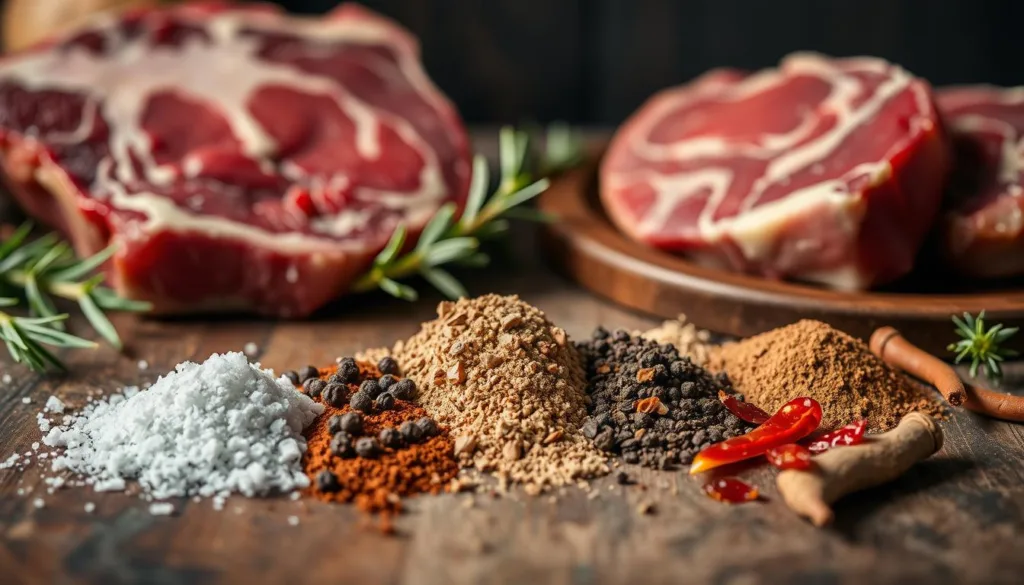
Step-by-Step Slow Cooking Method
Cooking beef cheeks tenderly is an art. Slow cooking breaks down tough tissues, making the meat soft. Here’s how to slow cook beef cheeks like a pro:
- Brown the beef cheeks in hot oil. This seals in flavors and gives a nice sear.
- Sauté diced onions, carrots, and celery in the same pan. These veggies add depth to the dish.
- Stir in tomato paste and cook for a minute. This boosts the flavor.
- Use red wine to deglaze the pan. This brings out the flavors from the bottom.
- Put the browned beef and veggies in a slow cooker. Add enough beef stock to cover the meat.
- Add thyme, bay leaves, salt, and pepper. Season well.
- Cook on low for 8 hours. The meat should be tender and easy to shred.
- Strain the cooking liquid and discard solids. Return it to the slow cooker. Thicken with cornstarch.
- Simmer the sauce for 30 minutes on high. Stir often until it’s thick enough.
Serve the beef cheeks with the rich sauce. Pair it with your favorite sides for a delicious meal. Enjoy the soft texture and bold flavors of this slow cooking recipes and braised meats dish.
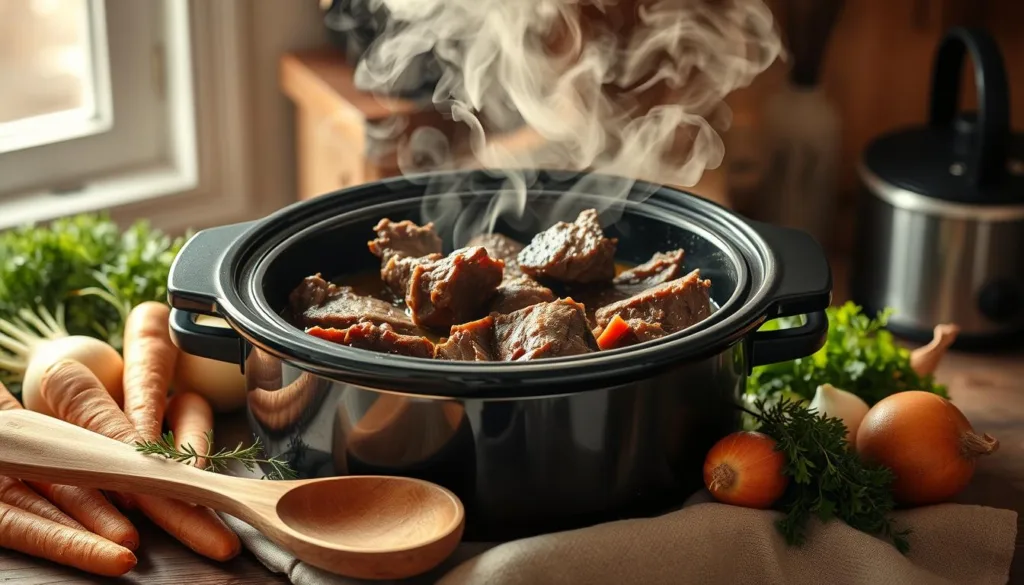
Alternative Cooking Techniques
Beef cheeks are a hidden gem for high-protein meals. They deserve your attention. While slow-cooking is great, you can try other methods for tender and flavorful beef cheeks.
Stovetop Braising Method
Start by searing the beef cheeks in a hot pan. This creates a tasty crust. Then, move the meat to a Dutch oven or heavy pot.
Cover it with a tasty braising liquid like beef stock and red wine. Let it simmer on low heat for 3-4 hours. This makes the beef very tender.
Oven Roasting Approach
Try oven roasting instead. Heat your oven to 160°C (320°F). Sear the beef cheeks first.
Then, roast them in the oven for 3-4 hours. Baste them with the cooking liquid now and then. This slow simmering process makes the meat tender and juicy, perfect for a flavorful dish.
Pressure Cooker Instructions
For quick cooking, use a pressure cooker. Sear the beef cheeks first. Then, put them in the cooker with your favorite liquid.
Cook on high pressure for about 1 hour.This method keeps the meat juicy and full of flavor, ensuring a delicious and tender result.
No matter the method, make sure to cover the beef in liquid. Cook until it’s very tender. This will make your meal extra special.
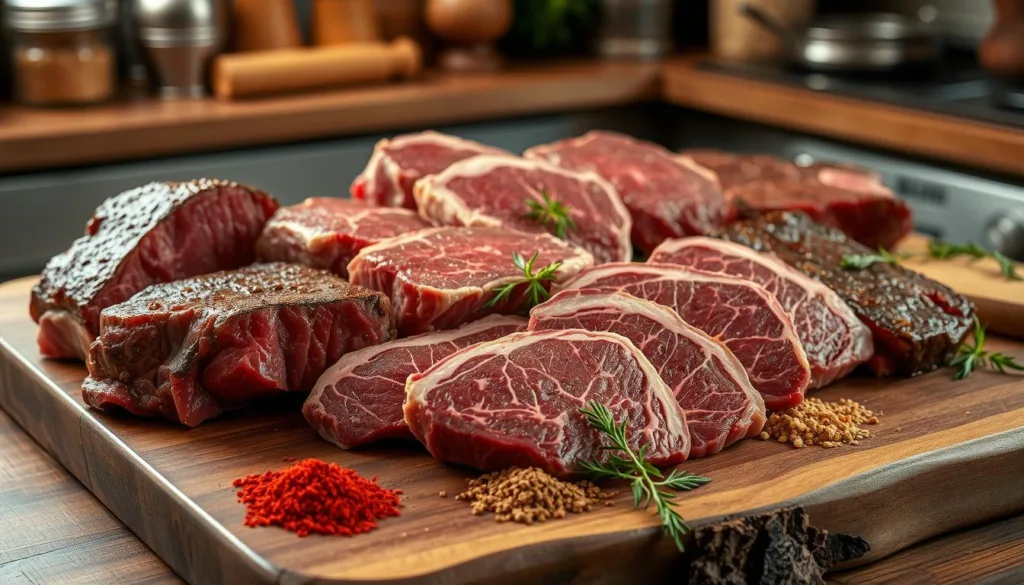
Creating the Perfect Sauce and Gravy
Improving your gourmet meat dishes, like tender beef cheeks, is about making great sauces and gravies. The right sauce can turn a good dish into an amazing one. It perfectly matches the rich, beefy taste of the meat.
To make the perfect sauce for your beef cheeks, start by straining the cooking liquid from the meat. This liquid is full of flavor and is the base of your sauce. Reduce it in a saucepan over medium heat. This lets the liquid get thicker and taste more intense.
To thicken the sauce, you can use a few methods. A cornstarch slurry, made by mixing cornstarch with a bit of the cooking liquid, makes it silky. Or, you can use a roux, made from butter and flour, for a velvety texture.
Adding red wine or balsamic vinegar to the sauce can add depth. These acidic elements balance the richness of the beef. Feel free to mix different herbs, spices, and aromatics to create your signature sauce.
The aim is to make a sauce that enhances the meat, not hides it. Taste and adjust the seasoning with salt and pepper. Keep tweaking until the sauce perfectly complements the beef nutrition and tenderness of the beef cheeks.
Wine Pairing and Cooking with Wine
Pairing wine with tender beef cheeks offers many options. A full-bodied red wine like Cabernet Sauvignon or Syrah is great. These wines match the rich flavors of the beef well.
Using a dry red wine to deglaze the pan is a smart move. It adds depth to the sauce. The alcohol evaporates, leaving a flavorful sauce. You don’t need an expensive wine; a good, affordable bottle works well.
| Wine Variety | Flavor Profile | Best Pairing |
|---|---|---|
| Cabernet Sauvignon | Full-bodied, bold, and tannic | Grilled or barbequed beef dishes |
| Syrah | Robust, with notes of blackberry and pepper | Braised or slow-cooked beef dishes |
| Merlot | Smooth and medium-bodied | Pot-roasted beef or osso bucco |
| Pinot Noir | Light and aromatic | Spicy chipotle beef dishes |
For great wine pairing, match the wine’s weight with the meat’s flavors. A bit of experimentation will find the perfect match for your high-protein meals.
Complementary Side Dishes
Choosing the right side dishes can make your beef cheeks meal even better. There are many options, from classic to modern, that go well with the meat.
Traditional Pairings
Classic sides for beef cheeks are creamy mashed potatoes, smooth polenta, or mashed cauliflower for less carbs. These sides contrast well with the beef, soaking up juices.
Modern Accompaniments
For a new twist, try roasted veggies like honey-glazed carrots, caramelized shallots, or asparagus. They add color and balance the meat’s richness with sweetness and crunch.
Also, a fresh arugula salad or cucumber-tomato salad can refresh your taste. They cut the richness of the beef, making the meal balanced.
| Traditional Pairings | Modern Accompaniments |
|---|---|
|
|
By picking the right side dishes, you can make a complete, protein-rich meal. It will highlight the beef cheeks’ tenderness and offer a mix of tastes and textures.
Storage and Leftover Tips
Cooking tender and flavorful beef cheeks is a treat. But what about leftovers? Don’t worry, I’ve got easy tips for storing and reheating. This way, you can enjoy every bite of your high-protein meal.
First, store leftover beef cheeks in an airtight container in the fridge. They stay fresh for 3-4 days, great for meal prep. To reheat, use the microwave at 50% power or gently on the stovetop.
For longer storage, freeze the beef cheeks for up to 3 months. This keeps your high-protein meal affordable and ready when you need it. Just thaw in the fridge overnight before reheating.
Shredding leftover beef cheeks is a favorite trick of mine. Add it to salads, sandwiches, or wraps. The rich flavor goes well with fresh greens and tangy dressings. It’s a quick way to make your leftovers into a tasty meal.
Beef cheeks taste even better after a day or two in the fridge. So, plan ahead and enjoy your leftovers a day or two later. The flavors will blend and intensify, making your meal even more enjoyable.
So, here are my top tips for using up beef cheek leftovers. With a bit of planning, you can make your high-protein meals last longer. And enjoy this budget-friendly, flavorful cut of meat even more.
Troubleshooting Common Cooking Issues
Exploring slow cooking beef cheeks has led to a few small problems. But, with some troubleshooting, I’ve solved these issues. Now, I get tender, tasty results every time.
If the beef cheeks are tough, they just needed more cooking. It’s key to make sure the liquid covers the meat. If the sauce is too thin, I thicken it with cornstarch or reduce it.
When the dish is too fatty, I chill it and remove the fat. If it’s too rich, a squeeze of lemon or some crème fraîche fixes it.
If you liked this article, you might also like :
- Delicious Protein Pancakes from our Breakfast category.

